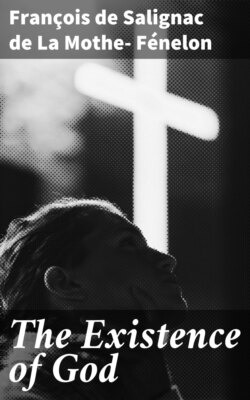Читать книгу The Existence of God - François de Salignac de La Mothe- Fénelon - Страница 21
На сайте Литреса книга снята с продажи.
SECT. XVII. Of the Sun.
ОглавлениеTable of Contents
But besides the constant course by which the sun forms days and nights it makes us sensible of another, by which for the space of six months it approaches one of the poles, and at the end of those six months goes back with equal speed to visit the other pole. This excellent order makes one sun sufficient for the whole earth. If it were of a larger size at the same distance, it would set the whole globe on fire and the earth would be burnt to ashes; and if, at the same distance, it were lesser, the earth would be all over frozen and uninhabitable. Again, if in the same magnitude it were nearer us, it would set us in flames; and if more remote, we should not be able to live on the terrestrial globe for want of heat. What pair of compasses, whose circumference encircles both heaven and earth, has fixed such just dimensions? That star does no less befriend that part of the earth from which it removes, in order to temper it, than that it approaches to favour it with its beams. Its kind, beneficent aspect fertilises all it shines upon. This change produces that of the seasons, whose variety is so agreeable. The spring silences bleak frosty winds, brings forth blossoms and flowers, and promises fruits. The summer yields rich harvests. The autumn bestows the fruits promised by the spring. The winter, which is a kind of night wherein man refreshes and rests himself, lays up all the treasures of the earth in its centre with no other design but that the next spring may display them with all the graces of novelty. Thus nature, variously attired, yields so many fine prospects that she never gives man leisure to be disgusted with what he possesses.
But how is it possible for the course of the sun to be so regular? It appears that star is only a globe of most subtle flame. Now, what is it that keeps that flame, so restless and so impetuous, within the exact bounds of a perfect globe? What hand leads that flame in so strait a way and never suffers it to slip one side or other? That flame is held by nothing, and there is no body that can either guide it or keep it under; for it would soon consume whatever body it should be enclosed in. Whither is it going? Who has taught it incessantly and so regularly to turn in a space where it is free and unconstrained? Does it not circulate about us on purpose to serve us? Now if this flame does not turn, and if on the contrary it is our earth that turns, I would fain know how it comes to be so well placed in the centre of the universe, as it were the focus or the heart of all nature. I would fain know also how it comes to pass that a globe of so subtle matter never slips on any side in that immense space that surrounds it, and wherein it seems to stand with reason that all fluid bodies ought to yield to the impetuosity of that flame.
In fine, I would fain know how it comes to pass that the globe of the earth, which is so very hard, turns so regularly about that planet in a space where no solid body keeps it fast to regulate its course. Let men with the help of physics contrive the most ingenious reasons to explain this phenomenon; all their arguments, supposing them to be true, will become proofs of the Deity. The more the great spring that directs the machine of the universe is exact, simple, constant, certain, and productive of abundance of useful effects, the more it is plain that a most potent and most artful hand knew how to pitch upon the spring which is the most perfect of all.
